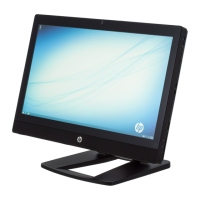System architecture
The HP Z1 G2 Workstation features the Intel® Xeon® processor E3-1200 v3
family and 4th generation Intel® Core™ processors based on the new Intel
micro-architecture. Upgraded ME9 manageability, Intel-integrated USB 3.0 and
optional Thunderbolt
TM
2 features deliver improved productivity and stability.
New technologies
New Intel Processor micro-architecture
The Z1 G2 supports Intel’s next generation processors, featuring a new micro-architecture and a new instruction set
including AVX2 (Advanced Vector Extensions 2.0) and FMA (Floating-point fused Multiply Add instructions) that help
deliver faster compute performance, with low energy consumption. Both the latest Quad Core Intel Xeon processor
E3-1200 v3 Product Family and the 4th generation Intel Core processors (dual-core Intel Core i3 and Intel Core i5
processors) are supported. The Intel C226 PCH (platform controller hub) chipset complements the Z1 G2’s core architecture.
Intel Advanced Vector Extensions 2.0 (Intel AVX2)
The new Intel Advanced Vector Extensions 2.0 (Intel AVX2) extends the Intel Advanced Vector Extensions (Intel AVX)
with 256-bit integer instructions, oating-point fused multiply add (FMA) instructions, and gather operations.
The 256-bit integer vectors benet math, codec, image, and digital signal processing software. FMA can improve
performance in face detection, professional imaging, and high-performance computing. Gather operations increase
vectorization opportunities for many applications. In addition to the vector extensions, this generation of Intel processors
adds new bit manipulation instructions useful in compression, encryption, and general purpose software.
Intel Data Protection Technology with AES-NI (Intel AES-NI)
The Intel Advanced Encryption Standard New Instructions (Intel AES-NI) are a set of Single Instruction Multiple Data
(SIMD) instructions that enable fast and secure data encryption and decryption based on the Advanced Encryption
Standard (AES). Intel AES-NI is valuable for a wide range of cryptographic applications, such as applications that perform
bulk encryption/decryption, authentication, random number generation, and authenticated encryption. AES is broadly
accepted as the standard for both government and industry applications, and is widely deployed in various protocols.
Next generation Intel® Active Management Technology
New features for Intel AMT 9.0 include:
• The Intel AMT network can now be enabled and disabled.
• Any conguration software can now synchronize the Intel AMT network time to coordinate with UTC.
• The ability to congure a headless platform remotely without the need for local user-consent has been added.
• Graceful restart support.
– ME8 only supported hard power operations, which can cause unpredictable system behavior. ME9 adds support for
graceful power operations that include shutdown / Reset / Sleep-deep / Hibernate to improve system stability.
Intel HD Graphics P4600
The new integrated Intel HD Graphics P4600 graphics engine provides professional entry graphics performance.
Available on Intel Xeon® processor E3-12x5v3 models, it comes certied for selected popular workstation applications.
The Intel HD Graphics P4600 graphics core integrated in Intel Xeon processors has 2 graphics cores and 20 Execution
Units and oers higher performance than the previous generation Intel HD Graphics P4000, which has 16 Execution Units.
The Intel HD Graphics P4600 supports Microsoft DirectX11.1, OpenCL 1.2 and OpenGL 4.0. It supports expanded media
acceleration features like full hardware decode and encode acceleration as well as advanced video processing features.
1866 MHz memory
The Z1 G2 supports standard DDR3 1866MHz ECC and non-ECC unbuered DIMMs. 1.5V and 1.35V DIMMs are supported
and both run at 1.5V. This is the same technology as the HP Z230 platforms. The speed that the memory runs is
controlled by the processors, which is 1600MHz for this generation. Future processor refreshes are expected to support
1866MHz. Oering 1866MHz now allows a smooth transition for customers when the new processors are introduced.
Touch
The Z1 G2 oers a base unit with a touch panel option. The touch panel is a 27” panel with glass on glass ITO. It supports
10-point multi-touch with nger or capacitive stylus input. The accuracy of the panel is 1mm to each target and 10% jitter
limit on moving (Win8). The panel has two controller boards that connect via USB 2.0 to the motherboard.
Technical white paper | HP Z1 G2 Workstation
4
HP recommends Windows.

